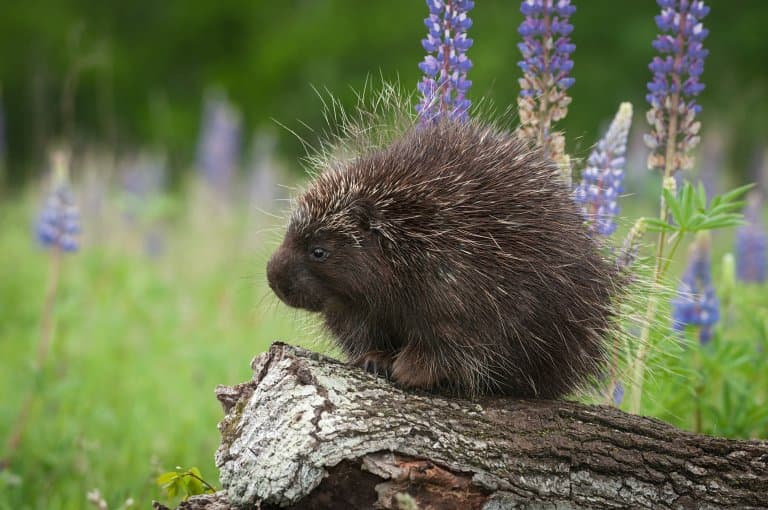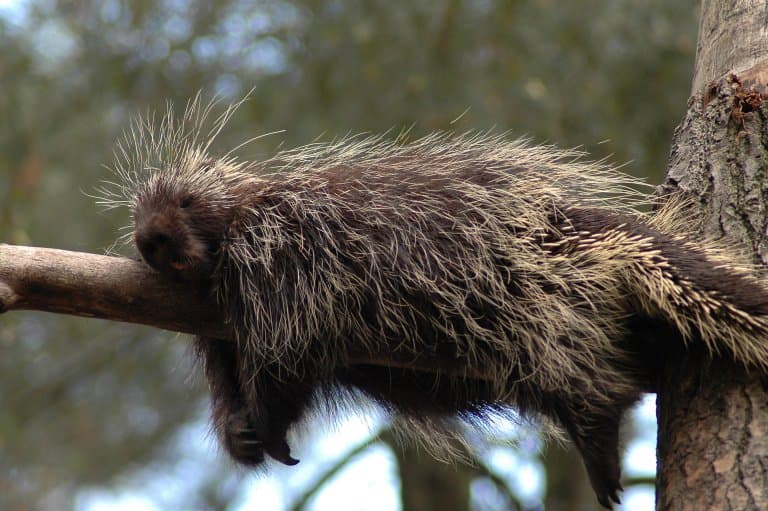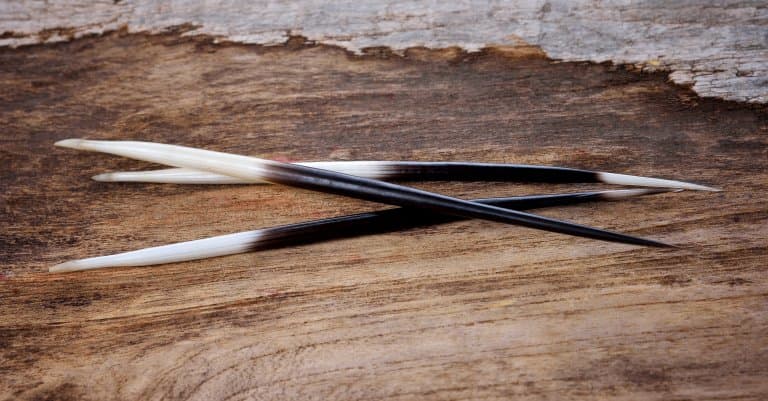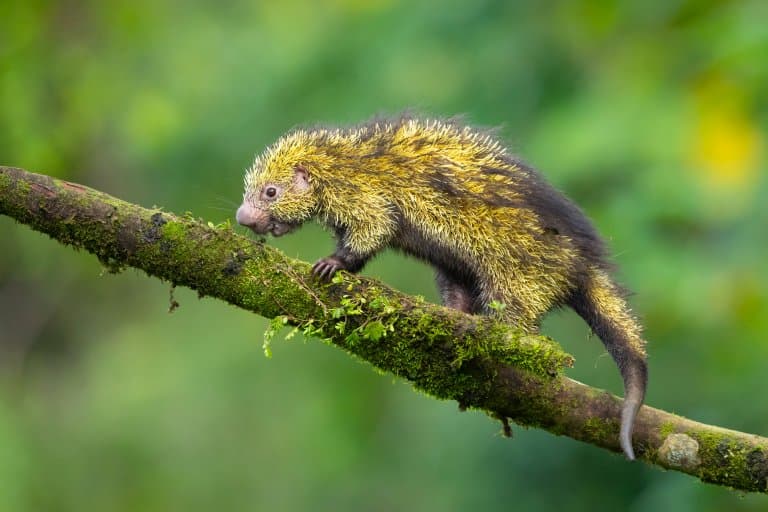Porcupine Profile
Porcupines are rodents with an interesting way to protect themselves from predators. They wear a coat of sharp quills all over their body.
There are two different families of porcupines. There is hystricidae, or Old World Porcupines, and Erethizontidae, the New World Porcupines.
Both families have distinct locations. The old world variety can be found in southern parts of Europe, western and southern Asia and throughout most of Africa. The new world variety is in North and South America.

Porcupine Facts Overview
| Habitat: | Forests, deserts, rocky hillsides |
| Location: | Europe, western & southern Asia, Africa, north & south America. |
| Lifespan: | 5 – 6 years |
| Size: | 60 – 90 cm (25 – 35 in) |
| Weight: | 12 – 35 pounds (5- 16 kg) |
| Color: | Brown, black, grey, yellow & even white |
| Diet: | Herbivore – Leaves, plants, twigs, bark |
| Predators: | Fishers, coyotes, cougars, bobcats, foxes, lynxes, bears, wolves |
| Top Speed: | 4 kph (2 mph) |
| No. of Species: |
58 species |
| Conservation Status: |
Least concern |
You can usually find porcupines living in parts of Asia, Southern Europe, Africa, North and South America with a tendency to gravitate towards tropical and temperate climates.
They generally inhabit forests, deserts, hill sides and rocky outcrops. There are some New World Porcupines who live in trees, while Old World Porcupines remain on the rocks. These ones can be found on rocky areas up to 12,000-feet in elevation.
They’re large, heavy rodents, with long life spans and a wide range of vocalisations. Their calls have fuelled legends, and their quills are notoriously effective.
Regardless of the family, most porcupines are about the same size. They are about 25 to 35-inches long, have an 8 to 10-inch tail and weigh between 12 and 35-pounds. They have a large, round body and move slowly.
The coloring of porcupines varies from shades of brown to grey and white. The spiny outer protective layer of a porcupine resembles that of hedgehogs, which are not related.
The name porcupine comes from the Latin words ‘porcus’ and ‘spina’ which translate to mean ‘pig spine’, or ‘quill pig’.
Interesting Porcupine Facts
1. They are known as ‘quill pigs’
The name porcupine means “quill pig”, but they’re not pigs. And, despite looking like hedgehog badgers, they’re not a member of those orders, either.
Porcupines are rodents, but very different from one another. The two families are not even closely related; the Rodentia order is exceptionally diverse, and despite looking similar, new and old-world quill pigs actually evolved their quills independently, through a process of convergent evolution.
This means they do not share a common spiny ancestor.

2. They’re one of the biggest rodents in the world
As rodents, their teeth are continuously growing and they have to gnaw on hard, woody morsels to keep them sharp and trim. They’re also pretty huge.
After the enormous capybara, the crested porcupine battles it out at around 30kg with the North American beaver for the title of second-largest rodent. 1
3. They’re possibly the longest-living rodent
Another thing they have to argue about is who lives the longest.
At 32 years, the longest-living porcupine is a contender for the highest longevity of any rodent, but the elusive naked mole rat, with its cancer-defying genes and weird social habits, may be found to live longer. So far, the results are inconclusive.

4. A group of porcupines is called a ‘prickle’
If you thought they couldn’t get any cuter, you’re in for a treat. A monogamous pair of porcupines will bring up 1-4 babies, known as porcupettes.
They’ll hang out together, in trees, in groups called prickles. Despite the name, and much to the relief of the mother, they’re born with soft quills though their eyes are open and their teeth are ready.
5. They do occasionally feed on honey
While African porcupines live mostly on the ground, their American counterparts have taken to the trees. They mostly eat leaves and the occasional insect, and, at least in captivity, will happily feed on honey, which probably isn’t good for them – and it’s uncertain whether they’d willingly take on a wild bee nest!
The African Porcupine does not climb so it forages mostly on the ground, and is mostly nocturnal. It will sometime forage for food during the day and will eat a more varied diet that will include roots, fruits, berries, bark and farm crops.

6. They do occasionally fall out of trees
While honey may or may not be on the menu, tender leaves are more commonly eaten by tree-dwelling porcupines. This creates a certain danger due to how precariously placed the young leaf shoots are.
These delicacies of porcupine cuisine can be hard to reach at the end of slender branches, and trying will often result in a tumble to the forest floor.
It’s thought that these falls are rarely fatal, despite the weight of the animal, but there is a chance they can be injured on their own quills. 2

7. They do occasionally fall on people
In 2014, a Brazilian woman saved the life of a falling porcupine by selflessly presenting her scalp as a landing pad. The encounter left her with 272 quills embedded in her head.
So, there’s another thing to worry about! 3
8. They sound like babies
Porcupines are very vocal animals, expressing themselves while eating, courting, or just singing at night for no apparent reason. Porcupine nocturnal calls are thought to be one of the inspirations for creepy folklore takes about babies being left in the woods.
Individuals have a natural variation in their calls, called ‘singing’, with some natural tenors and baritones and the occasional soprano. They also appear to make adorable defensive noises when someone pushes a camera in their face while they eat.
9. Their quills are something special
Living among the most specialised and successful predators on earth, the porcupine has developed a very effective defence. Its 30,000 quills can be over a foot long and are brittle and hollow. They’re also barbed in new world species, helping them stay embedded in their would-be hunters’ skin after they inevitably snap off during an attack.
While the old-world species don’t have barbed quills, they are commonly driven deep enough to stick, and even honey badgers can sometimes be deterred. The quills are intricately crafted by evolution to penetrate the skin with half the force of a hypodermic needle.
This defence is so effective it’s been said to have killed many of the top predators of the porcupine, including hyenas, leopards and lions. 4
10. Their defensive response is pretty clear
The defensive response from a Porcupine depends on several factors. They include scent, sound and sight. Typically the porcupine will display defensive behavior when it gets annoyed or agitated.
There are four main displays that will come from an agitated, irritated and ticked off porcupine. They include quill erection, clattering teeth, the emitting of an odor and finally, an attack.
11. Porcupines do not throw their quills
Porcupines do not throw their quills, but they do break off at the base when the barbs at the tip of the quill penetrate something.
Quills are released through contact and sometimes a few may fall out when a porcupine shakes its body vigorously. Once a quill is released, a new one will grow in its place.

12. Porcupine populations have declined
This is partly due to the fact that they are a food source in some regions.While they are not regular menu items in Western culture, porcupines have been eaten on occasion.
They are, however, very popular in Southern Asia. In Vietnam particularly, porcupines are a prominent food source and that has contributed to a significant drop in the population in that region.

Porcupine Fact-File Summary
Scientific Classification
| Kingdom: | Animalia |
| Phylum: | Chordata |
| Class: | Mammalia |
| Order: | Rodentia |
| Suborder: | Hystricomorpha |
| Infraorder: | Hystricognathi |
| Families: | Hystricidae (Old World porcupines) Erethizontidae (New World porcupines) |
Fact Sources & References
- Nature Nibble (2022), “Do Porcupines Live Together? If so, how many?“, naturenibble.com.
- Dennis Bromley and Tim Osborne (2008), “Porcupine“, Alaska Department of Fish & Game.
- Susmita Baral (2014), “Porcupine Falls On Sandra Nabucco In Brazil Leaving Over 200 Quills In Her Head“, Latin Times.
- Sid Perkins (2012), “Porcupine Quills Reveal Their Prickly Secrets“, Science.org.
